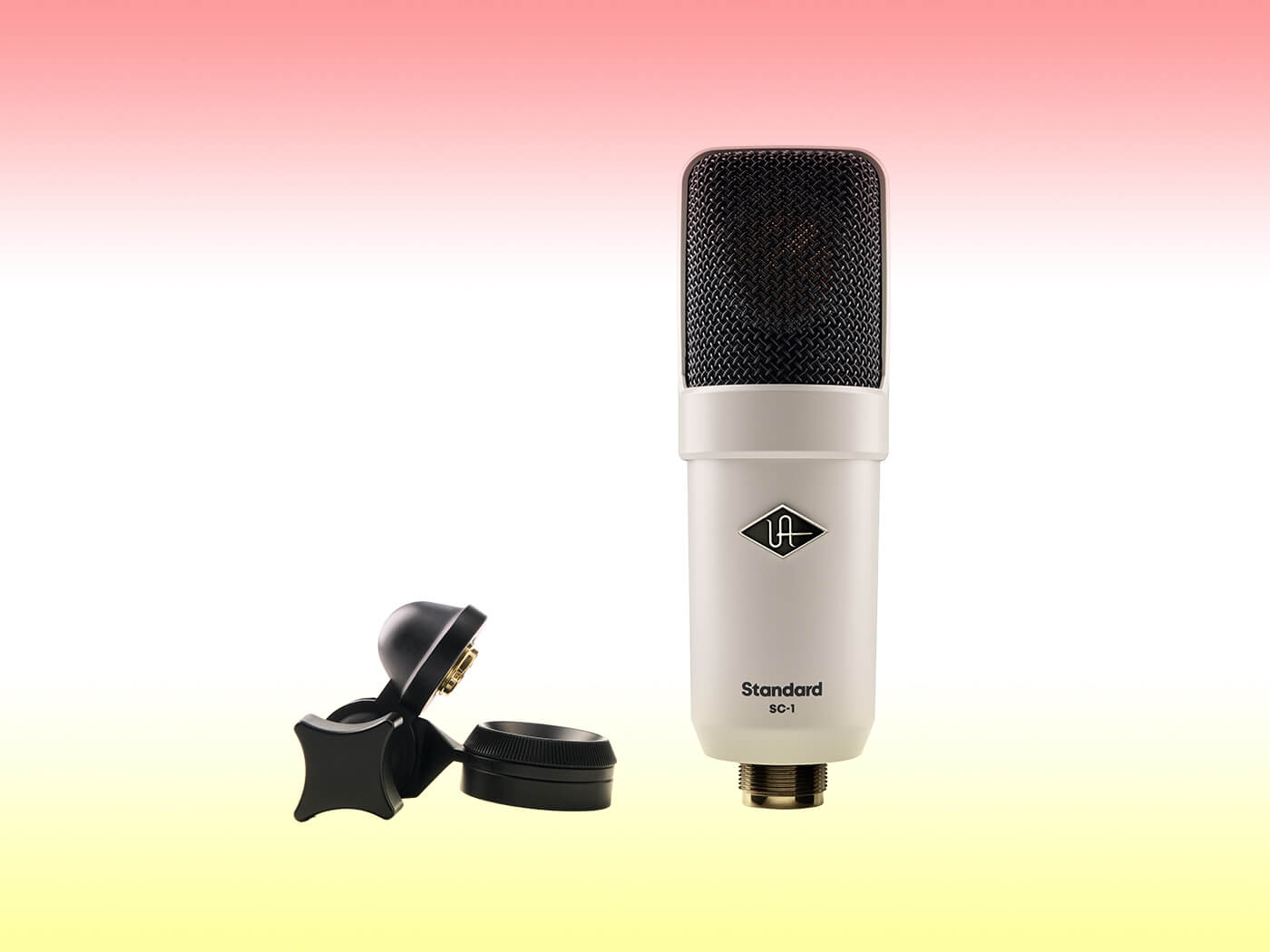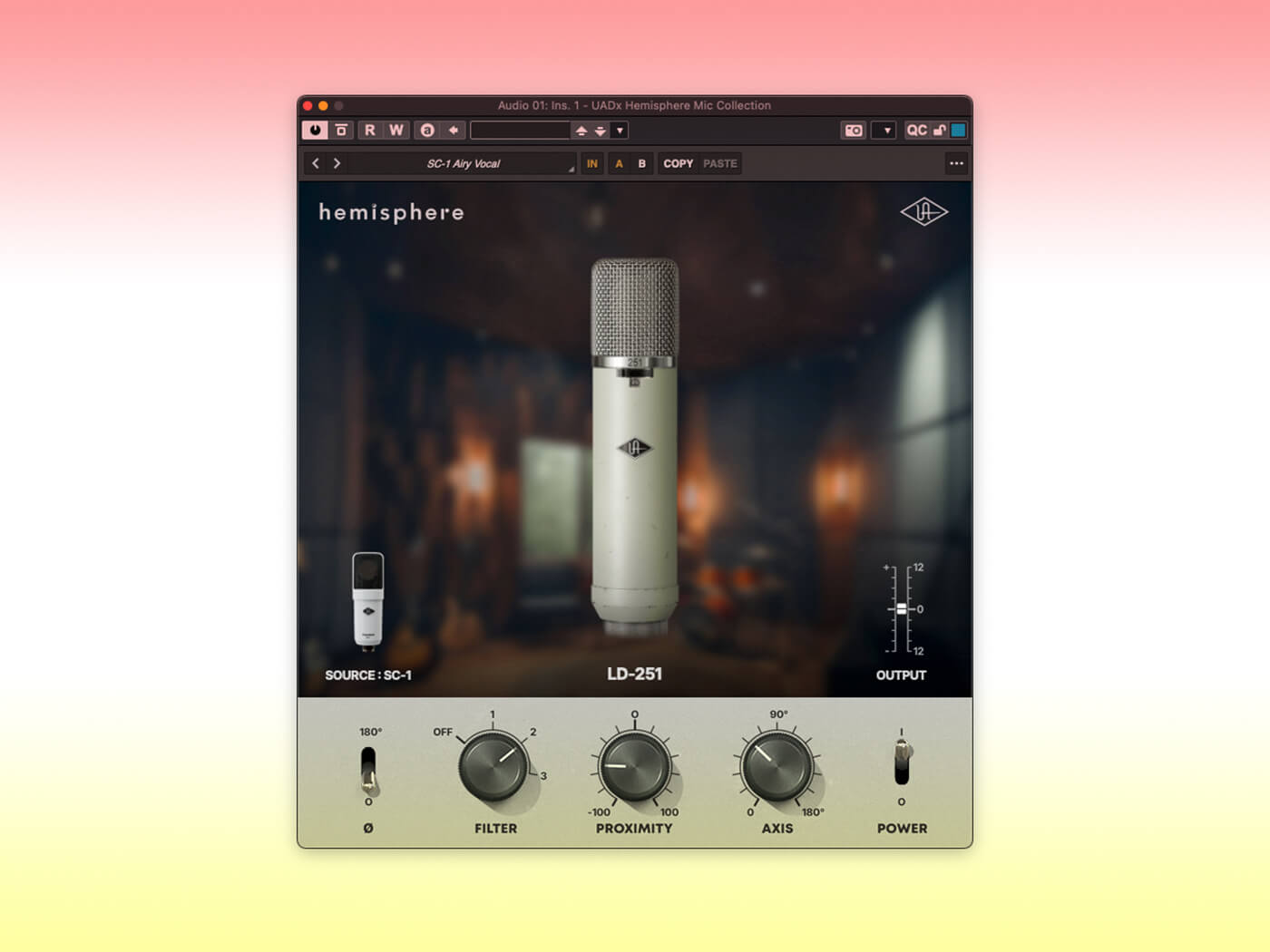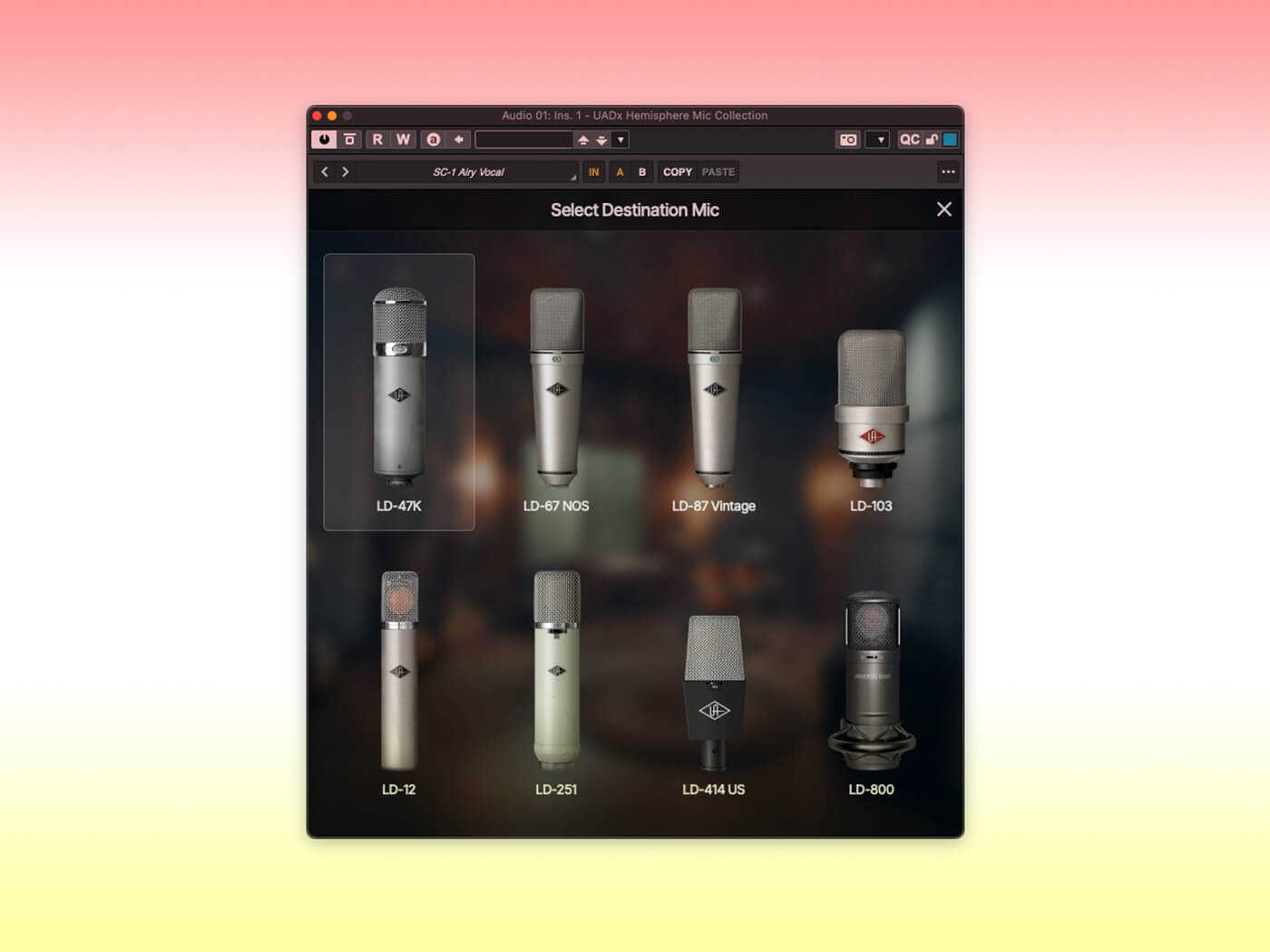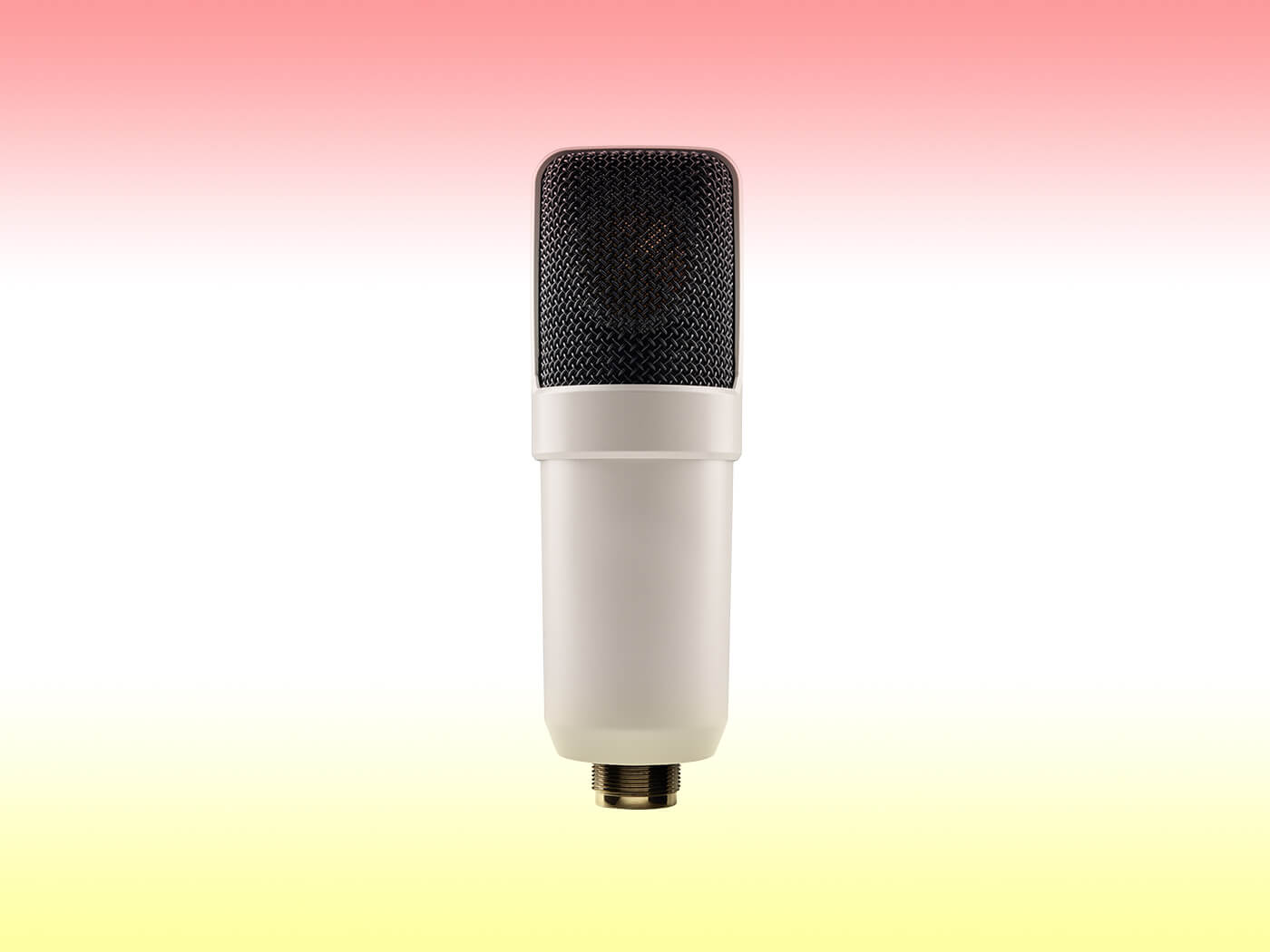Universal Audio’s SC-1 and Hemisphere eight-mics-in-one are tempting additions to any studio’s mic collection
A mic model is rarely as good as the real McCoy, but done well it can add a lot of flexibility. Besides, Universal Audio has form for doing it well.

Universal Audio SC-1 in use
Review Overview
Our rating
8
Our verdict
⊕ Hemisphere plugin with eight models of classic condenser mics
⊕ Adjust position of mic relative to sound source after recording
⊕ Worth the money with-or-without Hemisphere modelling
⊖ Needs a shock mount, but only includes a bracket-style mount
⊖ Serial number not easy to find
£475 / $499 (street price), uaudio.com
A couple of years back, Universal Audio and Townsend Labs released the Sphere microphone modelling system. The Sphere mics feature a pair of coincident capsules and an accompanying plugin analyses and manipulates the phase and tone differences between the capsules to create convincing emulations of various sought-after mics. A mic with two capsules is obviously going to be more expensive than a conventional mic, so UA has come up with a way of pulling off a similar trick using a more affordable single capsule mic.
The result is the new Hemisphere plugin (geddit? A hemisphere is half a sphere) and a series of three microphones that the system is calibrated to work with. Those microphones are the SD-1 Dynamic which can emulate dynamic mics, the SP-1 Pencil Pair, a small diaphragm condenser pair for stereo recording, and the SC-1 Condenser, which is the large diaphragm condenser mic that we’re reviewing here.
How does the UA SC-1 sound on its own?
The SC-1 mic is of a similar size and construction to many mid-priced condensers, with a cardioid pattern, 30mm diaphragm and chunky body. Unlike the Sphere mics, which require a special stereo splitter lead, the SC-1 (and the other Hemisphere mics) use standard three-pin XLR connectors and require only one input channel each.

The mic comes with a case, which also has room for the supplied hard-bracket mount. Sadly, this style of mount isn’t ideal for a mic like the SC-1 because it transfers too much rumble and noise through the stand and into the sensitive capsule. A shock mount would have been preferable, and would surely have had only a negligible impact on the asking price. By excluding one, all UA has done is force customers to hunt out and buy a separate compatible shock mount.
Used as a standard mic, without the Hemisphere plugin’s modelling, the SC-1 is a solid all-round performer. The sound is rich and full-bodied, and works well with everything we point it at. Thanks to its surprising tolerance for high signal levels, it can even turn its hand to a bit of drum mic’ing, although the absence of on-body pad and rolloff switches mean we wouldn’t recommend putting it inside a kick drum.
Like most large diaphragm condensers, though, the SC-1 is at its best when recording vocals, which it captures with a crisp and airy sound that has just the right amount of presence and clarity.

How to use the UA Hemisphere plugin
The Hemisphere plugin is a UAD2 plugin for use with UA’s Apollo and Satellite hardware, and as a native plugin that runs in your DAW. No need for any additional processing hardware here.

The plugin is free but you can only be download and activate it once you’ve registered the mic to your UA account. To do this, you need the mic’s serial number… but where is it? Not on the mic itself, nor on a card or label within the mic case; we only discovered it by typing in every number shown on the outer packaging until we eventually hit on the right one. We’e come to expect more attention to detail than this from UA!
Hemisphere can only do its thing if it knows the technical characteristics of the mic you’re using. So the first step when loading the plugin is to specify which of the three Hemisphere-compatible mics is connected. You can then select and configure a mic model. Unlike Sphere, which can model mics of different types (i.e. dynamic, ribbon and condenser), Hemisphere is restricted by the type of source mic. So the SC-1 can only model other large diaphragm condensers.
There are eight mic models to choose from but, thanks to good-old IP laws, none are given their real names, although their identity is strongly hinted at in the included descriptions.
What are the SC-1’s mic models like?
The expected brace of Neumann classics are here in the form of a U 47, U 67 and U 87, along with its modern-classic, the TLM 103. Telefunken’s vintage ELA M 251 makes an appearance, and from just over the border in Austria, there’s AKG’s classic C-12 as well as its coveted C-414. Finally, from Japan, there’s a model of the modern Sony C-800G, a particularly popular choice for hip-hop vocals.

All of these mics are revered vocal mics but many are also known for being promising matches for other instruments. For example, the Telefunken 251 is great for drum overheads, the U 87 sounds stunning with guitar amps, and the AKG C-414 is reliable with pretty much anything you wish to throw at it.
That said, we don’t find the models quite as convincing as those delivered by UA’s Sphere system, although all are effective and give the SC-1 a huge amount of versatility.
Along with the choice of different mics, Hemisphere also allows adjustment of the apparent position of the mic relative to the sound source via proximity and axis controls. Mic positioning is an art, and even the pros don’t always get it right, so being able to modify that positioning after the performance is committed to digital bits is a massive help.
You can also change any pad or filter switches the modelled mic may have – again, a really useful thing to be able to do to an already-recorded mic signal.
Should you buy the UA SC-1 and Hemisphere?

Just like the Sphere system, Hemisphere multiplies the value of your investment by giving you a whole collection of microphones for the price of one. Unlike Sphere, though, you are limited to models of the same type of mic as the actual physical one, so to get a similar range of flexibility you’d need to buy all three Hemisphere mics. The cost of this is not dissimilar to the cost of the top-end Sphere mic, although you would of course have the benefit of having more actual microphones.
The Hemisphere modelling works well, but isn’t quite on the same level as Sphere. The physical mic itself is easily worth the asking price, though, so even if the modelling were only half as good as it is, the SC-1 would still make for an attractive and tempting addition to any studio’s mic collection.
Key features
- Large diaphragm condenser microphone
- Cardioid
- Works with Hemisphere mic modelling plugin
- Hemisphere plugin for UAD2 and native VST/AU/AAX
- Frequency range: 20Hz – 20kHz
- Self noise: 12dB
- Maximum SPL: 145dB
- Impedance: 200 Ohms
- Comes with carry case and mount